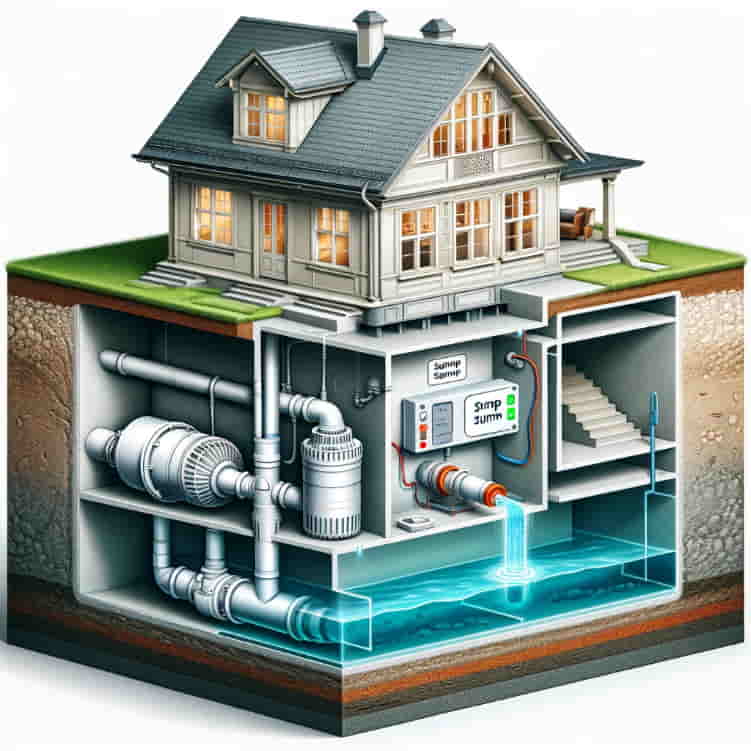Your basement is your home’s hidden layer, often housing valuables and essential utilities. Protecting it from the insidious threat of water intrusion is crucial, and a reliable sump pump system plays a vital role. But the pump alone isn’t enough. It needs a keen sentinel – a sensor – to trigger its action precisely when water levels rise. Choosing the right sensor ensures efficient pumping, preventing overflow and costly damage.
This guide demystifies the world of sump pump sensors, equipping you with the knowledge to pick the perfect one for your needs.
Types of Sump Pump Sensors:
1. Float Switch: The classic and most common sensor, a float switch bobs with the water level. When it reaches a predetermined point, it activates the pump, and when the water recedes, it deactivates the pump.
- Pros: Simple, affordable, and reliable.
- Cons: Can get caught on debris, leading to malfunction. Doesn’t offer precise water level control.
2. Tether Switch: A weighted tethered cable hangs vertically in the pit. As the water rises, the weight descends, triggering the pump at a specific level. When the water falls, the weight rises, stopping the pump.
- Pros: More precise than float switches, offering customizable activation points. Less prone to debris interference.
- Cons: Requires proper alignment and can be sensitive to pit movement. Installation might be more complex.
3. Pressure Switch: Uses hydrostatic pressure from the water column to activate the pump. As the water level rises, the pressure increases, triggering the pump. When the pressure drops, the pump stops.
- Pros: Highly accurate and versatile, working in deep or narrow pits. Not affected by debris or movement.
- Cons: More expensive than other options. Installation requires expertise and additional equipment.
4. Electronic Sensors: Utilizing ultrasonic, capacitance, or infrared technology, these sensors detect water level changes without physical contact.
- Pros: Contactless, eliminating debris issues. Highly accurate with customizable settings. Some models offer advanced features like alarm notifications.
- Cons: Most expensive option. Sensitive to pit conditions and require careful calibration.
Choosing the Right Sensor for Your Needs:
Consider these factors when making your decision:
- Budget: Float switches are the most economical, while electronic sensors come with a premium price tag.
- Pit size and shape: Tether switches work best in narrow pits, while pressure switches handle deep pits well. Electronic sensors offer flexibility.
- Water intrusion rate: If your basement receives heavy or sudden water influx, opt for a fast-acting sensor like a pressure switch or high-quality electronic sensor.
- Desired precision: For critical applications or peace of mind, choose a sensor with precise water level control like a tether switch or advanced electronic model.
Additional Tips:
- Backup power: Consider a battery backup system for your sump pump, especially if you live in an area prone to power outages.
- Alarm system: Some sensors offer built-in alarms or connect to smart home systems, alerting you to potential flooding even when you’re away.
- Professional installation: For complex sensor types or if you’re unsure about your choice, seek help from a licensed plumber or electrician.
Conclusion:
Your sump pump sensor is a silent guardian, standing vigil against basement floods. By understanding the different types, their strengths and weaknesses, and your specific needs, you can choose the perfect sensor to ensure your subterranean haven remains dry and safe. Remember, proper maintenance and regular inspections are crucial for optimal performance and peace of mind. investing in the right sump pump sensor is an investment in your home’s safety and value. Choose wisely and sleep soundly knowing your basement is protected from the watery depths.
Further Resources:
- National Flood Insurance Program: fema.gov/flood-insurance
- The Water Pump Store: sumppumpsdirect.com/
- International Association of Plumbing and Mechanical Officials: codes.iapmo.org

 January 17th, 2024
January 17th, 2024  Arnold
Arnold 
 Posted in
Posted in 